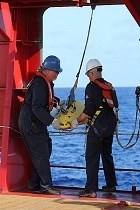Possible Signals From Jet's Black Boxes Heard by Australian Ship

Possible signals from lost jet's black boxes heard
Underwater sounds picked up by a search vessel scouring the remote Indian Ocean for the missing Malaysia Airlines jet are consistent with the pings from aircraft black boxes, an Australian official said Monday, dubbing it "a most promising lead" in the month-long hunt for the vanished plane.
Angus Houston, the head of a joint agency coordinating the search in the southern Indian Ocean, warned that it could take days to confirm whether the signals picked up by the Australian navy ship Ocean Shield are indeed from the flight recorders on Flight 370, but called the discovery very encouraging.
"Clearly this is a most promising lead, and probably in the search so far, it's probably the best information that we have had," Houston said at a news conference.
"We've got a visual indication on a screen and we've also got an audible signal — and the audible signal sounds to me just like an emergency locator beacon."
After a month-long search for answers filled with dead ends, Monday's news brought fresh hope given that the two black boxes, which contain flight data and cockpit voice recordings, are the key to unraveling exactly what happened to Flight 370 and why.
There was little time left to locate the devices, which have beacons that emit "pings" so they can be more easily found. The beacons' batteries last only about a month — and Tuesday marks exactly one month since the plane disappeared during a flight from Kuala Lumpur, Malaysia, to Beijing with 239 people on board.

The Australian navy's Ocean Shield, which is carrying high-tech sound detectors from the U.S. Navy, picked up two separate signals late Saturday night and early Sunday morning within a remote patch of the Indian Ocean far off the west Australian coast that search crews have been crisscrossing for weeks. The first signal lasted two hours and 20 minutes before it was lost. The ship then turned around and picked up a signal again — this time recording two distinct "pinger returns" that lasted 13 minutes, Houston said.
"Significantly, this would be consistent with transmissions from both the flight data recorder and the cockpit voice recorder," Houston said.
Still, Houston cautioned that it was too early to say the transmissions were coming from the black boxes on the missing passenger jet.
"I would want more confirmation before we say this is it," he said. "Without wreckage, we can't say it's definitely here. We've got to go down and have a look."
The airliner's black boxes normally emit a frequency of 37.5 kilohertz, and the signals picked up by the Ocean Shield were both 33.3 kilohertz, said U.S. Navy Capt. Mark Matthews. But officials contacted the device's manufacturer and were told the frequency of black boxes can drift near the end of their shelf lives.
The Ocean Shield was slowly canvassing a small area trying to find the signal again on Monday, something that could take another day to complete, Matthews said.
"It's like playing hot and cold when you're searching for something and someone's telling you you're getting warmer and warmer and warmer," he said. "When you're right on top of it you get a good return."
If they pick up the signal again, the crew will launch an underwater autonomous vehicle to investigate further, Matthews said. The Bluefin-21 autonomous sub can create a sonar map of the area to chart out where the debris may lie on the sea floor. If it maps out a debris field, the crew will replace the sonar system with a camera unit to photograph any wreckage.
But that may prove tricky, given that the sub can only dive to about 4,500 meters (14,800 feet) — the approximate depth of the water — meaning the vehicle will be operating to the limits of its capability.
Given the difficulties involved, officials warned the mystery of Flight 370 would still take time to resolve.
"It could take some days before the information is available to establish whether these detections can be confirmed as being from MH370," Houston said. "In very deep oceanic water, nothing happens fast."
Meanwhile, the British ship HMS Echo, which is fitted with sophisticated sound-locating equipment, was trying to determine whether two separate sounds heard by a Chinese ship about 555 kilometers (345 miles) away from the Ocean Shield were related to the plane. The patrol vessel Haixun 01 first detected a brief "pulse signal" on Friday, and a second signal on Saturday.
The crew of the Chinese ship reportedly picked up the signals using a sonar device called a hydrophone dangled over the side of a small boat — something experts said was technically possible but extremely unlikely. The equipment aboard the British and Australian ships is dragged slowly behind each vessel over long distances and is considered far more sophisticated.


Post your comment
You cannot post comments until you have logged in.
Login to post a commentComments
No one has commented on this page yet.
RSS feed for comments on this page | RSS feed for all comments